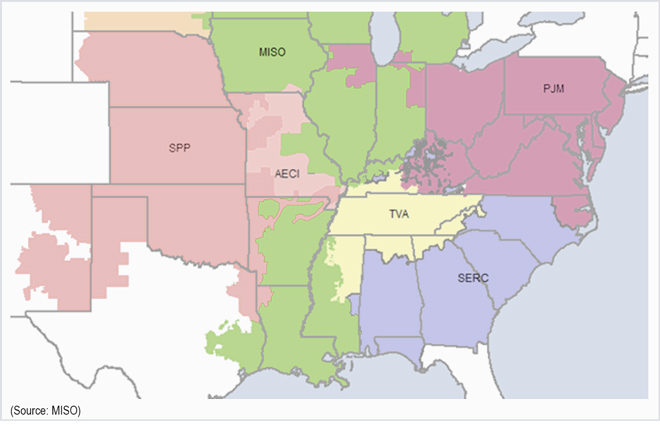By Chris O’Malley
MISO on Wednesday got an earful of stakeholder suggestions about how to spur interregional transmission projects at the seams with PJM and SPP.
They range from adopting common evaluation criteria to removing barriers for lower voltage projects to creating a new category for interregional projects.
One thing most agreed on during a “hot topics” discussion of the Advisory Committee is that the current process is not working.
Of the roughly $15.5 billion in transmission projects at MISO from 2008 to 2014, “We’ve had zero spent on interregional projects,” Kip Fox, director of asset strategy and grid development at American Electric Power, told the committee. “If this isn’t pretty clear evidence that the process is broken, I don’t know what it would be.”
“The current interregional transmission planning process has failed to meet [its] objectives and has not resulted in identifying a single interregional transmission project for approval,” agreed the Independent Power Producer sector.
Despite 12 years of joint meetings, MISO and PJM have been unable or unwilling to eliminate obstacles to cross-border projects. In February, the Federal Energy Regulatory Commission increased pressure on the two RTOs, saying it was considering taking action “to improve the efficiency of operations” at the RTOs’ seam. (See Impatient FERC Hints at Action on PJM-MISO Seams Disputes.) MISO also is working to resolve disputes with SPP.
“Even though we’ve made some progress, there still are challenges we need to work through,” acknowledged Jesse Moser, manager of strategic infrastructure at MISO.
Re-Evaluate Benefit-Cost Ratio
FERC’s Order 1000 requires interregional transmission planning but does not mandate that border-spanning projects be built.
“RTOs view compliance with Order 1000 as regularly scheduled meetings to facilitate discussion and data exchange. No plan or project is required,” said the Transmission Developer sector. “… Since 2012, over 121 project solutions along the MISO seams have been identified and summarily rejected.”
The transmission developers say MISO customers have paid more than $100 million in congestion, market-to-market costs and higher LMPs over the past four years due to inadequate transmission.
Interregional projects involving MISO and PJM must navigate three separate processes: MISO Transmission Expansion Planning regional criteria, PJM Regional Transmission Expansion Planning criteria and the cross-border process under the MISO-PJM Joint Operating Agreement.
One impediment to interregional projects, according to the developers and IPP sectors, is MISO’s requirement that interregional projects clear a 1.25 benefit-to-cost hurdle to win approval.
Both sectors say the 25% return on investment should be re-evaluated, and either lowered or broadened to capture more benefits.
“First, a project must meet the interregional criteria of providing a 25% return on investment based on a simulated adjusted production cost with perfect unit dispatch and no transmission outages,” said the developers. “Second, a project that passes the interregional criteria must now pass the regional criteria under the MTEP process using a different set of economic and powerflow models.”
MISO Director Eugene Zeltmann said he wondered whether the current ratio is detrimental to the process. But if the ratio were changed, he asked, “Would that have a deleterious effect on consumers?”
The developers say the definition of benefits should be expanded to include savings on capacity spending due to reduced transmission losses and capacity margins; avoided or delayed reliability projects; reduced emissions; and increased transmission revenues.
Reduce Voltage
Another impediment, according to some stakeholders, is that MISO has no provision for regional cost allocation for projects on low voltage transmission. MISO’s market efficiency projects are limited to projects of at least 345 kV, a much higher threshold than that of other regions.
The transmission developers said that most transmission between MISO and its neighbors is less than 300 kV. “MISO appears to be discriminating against lower-voltage projects that resolve reliability and economic solutions by making the requirement that the host zone needs to pay for the upgrade, even though the upgrade may benefit multiple zones,” they said.
The IPPs suggested projects as low as 100 kV be eligible for cost-sharing. “The current criteria was developed years before MISO’s seams expanded in the southern region,” they said.
Unify Metrics
Several stakeholder groups complained that the lack of a common set of metrics for cross-border project selection also is to blame. The Transmission Owners sector said planning should be consistent across seams and between the regional and interregional processes. “Ideally, a single transmission system model would be used in order to provide the highest level of accurate and consistent analysis,” they said.
The Transmission Dependent Utilities sector said it would support a MISO suggestion to create a new interregional project category. “It is neither productive nor efficient to consider a large number of potential candidate projects under two or three futures scenarios for which there is no consensus among the participating RTOs,” it said.
Defending Regional Differences
But in their minority comments within the Transmission Developer sector, AEP and Exelon noted that FERC has recognized the validity of regional differences in planning criteria.
The companies say using concurrent studies with identical criteria is “untenable.”
Instead, they say each RTO could post its market efficiency needs and congested flowgates and then invite stakeholders to submit regional and interregional proposals that could address those issues “more efficiently and cost-effectively than any regional proposals the RTOs may already be considering.”
Each RTO would determine what portion of its market efficiency issues is met by each of the interregional proposals. Cost apportionment would be in proportion to the benefits received by each RTO.
Backyard Projects First
MISO and PJM recently have been discussing “quick hit” flowgate projects on either side of the border that could relieve market-to-market congestion. The four low-voltage projects identified so far as most promising could generate congestion savings of more than $90 million, the RTOs said during the Interregional Planning Stakeholder Advisory Committee meeting April 14. (See Quick Hit List at PJM-MISO Seam Narrowed to 4 Projects from 39.)


